How go is played
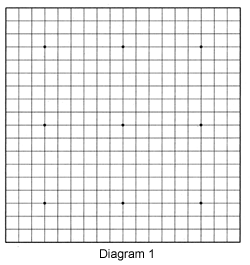 The board and stones
The board and stonesGo is usually played on a 19x19 grid called a board. Diagram 1 shows the empty board. Note the nine marked points. These are referred to as the "star-points." They serve as points of reference as well as markers on which stones are placed in handicap games.
The pieces used are black and white lens-shaped disks called stones. They are usually made of plastic or glass; in more expensive sets, the white stones are made from clam shells and the black from slate. No matter what materials they are made from, they are referred to simply as "stones." Black starts out with 181 stones and White with 180. The total of 361 stones corresponds to the number of intersections on the standard 19x19 go board. It is customary to keep the stones that have not yet been played in a wooden bowl next to the board.
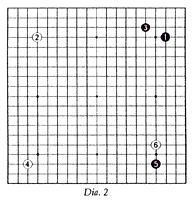 At the beginning of the game the board is empty. One player takes the black stones, the other player the white stones. The player with black makes the first move by placing a stone on an intersection. He may play on any unoccupied intersection, but it is usual to make the initial moves of the game near the corner star-points. Once a stone is played, it does not move unless it is captured and taken off the board. Diagram 2 shows a typical opening. Black makes his first move at 1 in the upper right corner, then White makes his first move at 2 in the upper left corner. Thereafter, both sides alternate in making their moves. Notice that in the opening neither side strays very far from the corners.
At the beginning of the game the board is empty. One player takes the black stones, the other player the white stones. The player with black makes the first move by placing a stone on an intersection. He may play on any unoccupied intersection, but it is usual to make the initial moves of the game near the corner star-points. Once a stone is played, it does not move unless it is captured and taken off the board. Diagram 2 shows a typical opening. Black makes his first move at 1 in the upper right corner, then White makes his first move at 2 in the upper left corner. Thereafter, both sides alternate in making their moves. Notice that in the opening neither side strays very far from the corners.
Four basic rules
1. Moves are played on the intersections.2. The stones do not move after being played.
3. Black plays first.
4. Black and White alternate in making their moves.
The object: to control territory
The object of go is to control territory. At the end of the game, the side which controls most territory wins. Some Japanese businessmen like to think of this as market-sharing: you don't try to destroy your competitor as in a chess game; rather, you coexist with him, but try to gain a greater share of the market.I am now going to show you how territory is taken in a game on a 9x9 board. Although a game on this size board is not as complicated strategically as one on a 19x19 board, the rules and tactics on a 9x9 board are the same. I recommend that you master the rules on a 9x9 board before graduating to the full-size board.
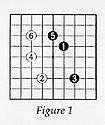 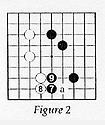 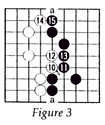 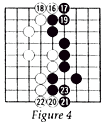 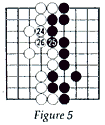 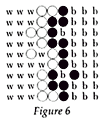 |
With the moves to White 6, both Black's and White's territories are beginning to take shape. Black has staked out the right side and White has laid claim to the left.
Once both players have mapped out their respective territories, there are two basic strategies to choose from. One is to expand your own territory while reducing your opponent's. The other is to invade the territory your opponent has mapped out.
Black 7 in Figure 2 follows the first strategy: Black expands his territory on the lower right while preventing White from expanding his own with a move at "a". White must defend at 8 to prevent an incursion by Black into his territory on the left. Next, Black reinforces his territory on the right with 9.
It is now White's turn to expand his territory. He first expands his center with 10 and 12 in Figure 3, then expands his territory on upper left with 14. Black must defend his top right territory with 15. Next, the points around "a" must be decided.
The moves from White 16 to Black 19 in Figure 4 are a standard sequence. A similar sequence is played at the bottom from White 20 to Black 23. By playing these moves, White expands his territory while reducing Black's.
White 24 to White 26 in Figure 5 are the last moves of the game. It is now possible to determine the winner. In this case, counting the score is easy.
Black's territory consists of all the vacant points he controls on the right side, while White's territory consists of all the vacant points he controls on the left. More precisely, Black's territory is all the points marked "b" in Figure 6 and White's territory is all the points marked "w". If you count these points, you will find that Black has 28 points while White has 27, so Black wins by one point. Notice that the points occupied by the black and the white stones are not counted.
This game was very simple and there were many aspects of the rules that did not arise, but it illustrates what go is about. In the next installment, I will explain how stones are captured.
For those living in the Tokyo metropolitan area who would like to pursue go more intensely, classes for beginners are held in English every Monday evening at the Takadanobaba Go Club (03-3208-0279) in Shinjuku Ward, near the east exit of JR Takadanobaba Station. In addition, the Japan Go Association (03-3288-8727) near JR Ichigaya Station in Shinjuku Ward provides a venue for beginners to play every Wednesday and Thursday from noon to 9 pm.
Go books are on sale at most bookstores in Japan that sell English-language books. The best beginners' book is Go: A Complete Introduction to the Game by Cho Chikun. Cho holds the top three Japanese titles-Kisei (sponsored by The Yomiuri Shimbun), Meijin, and Honinbo-and is perhaps the strongest player in the world.
